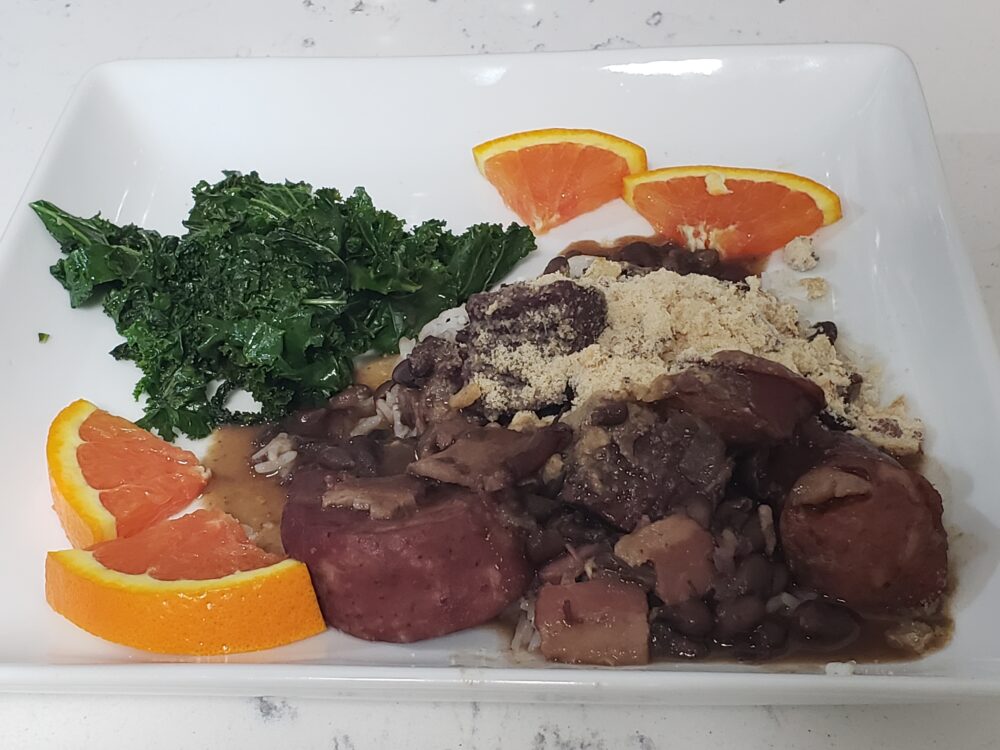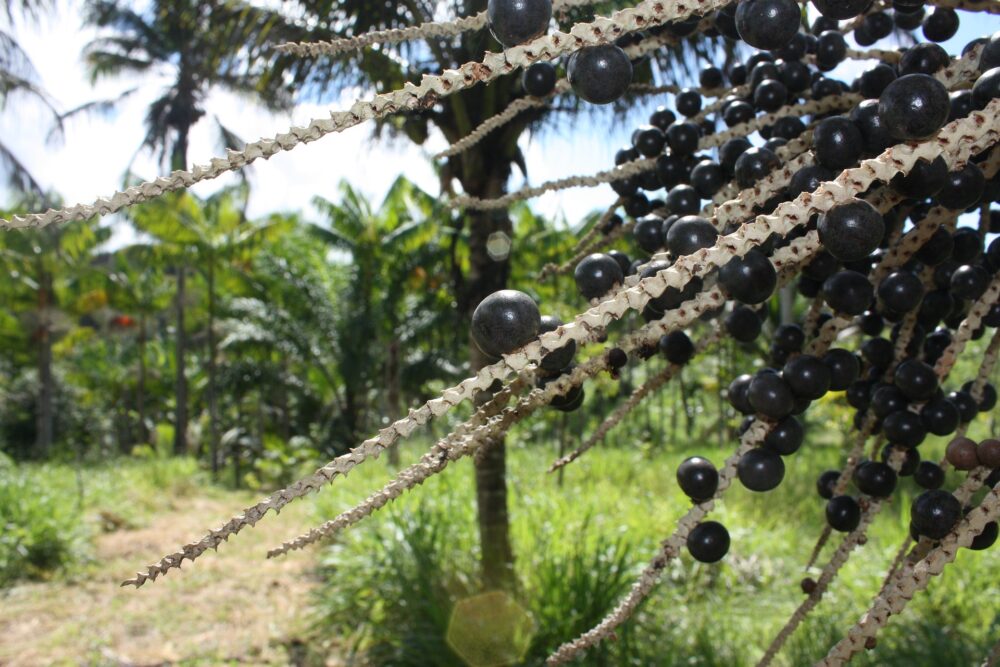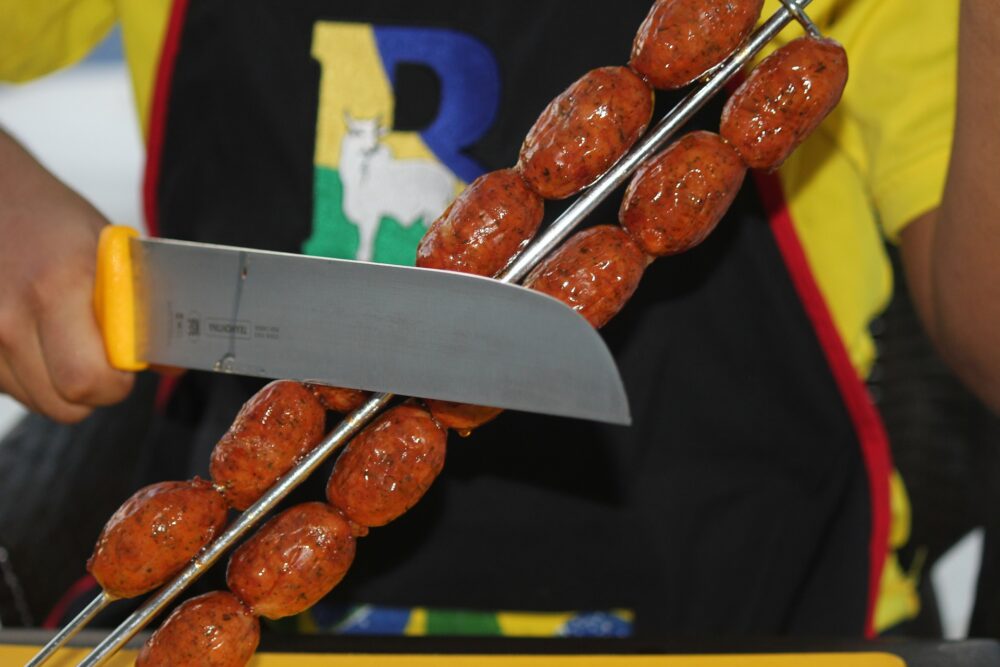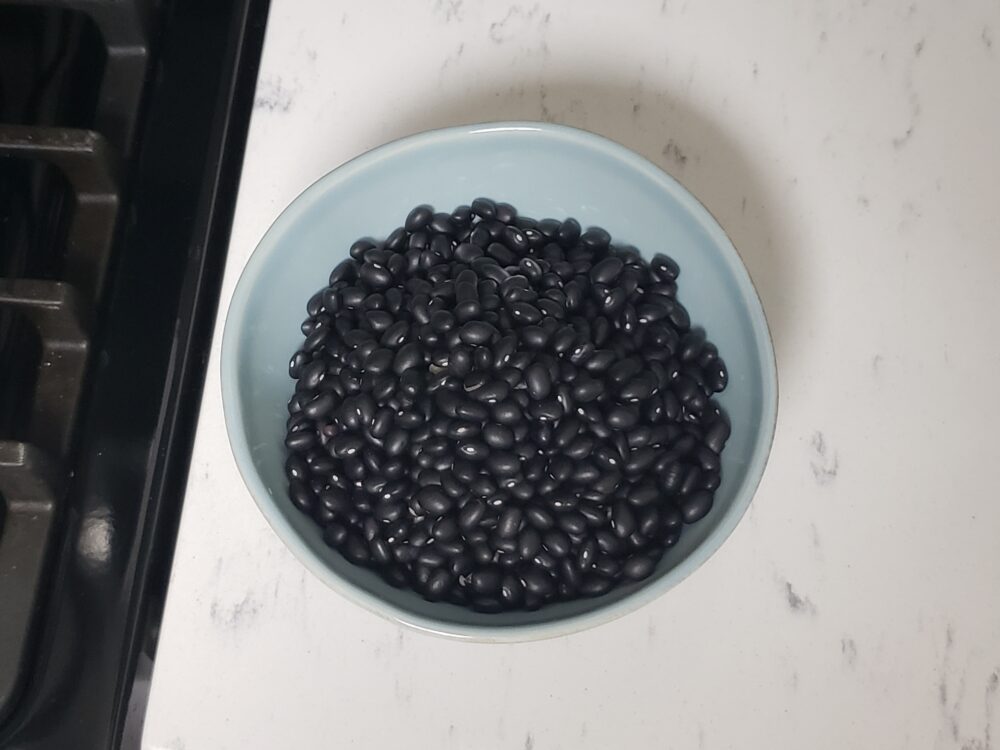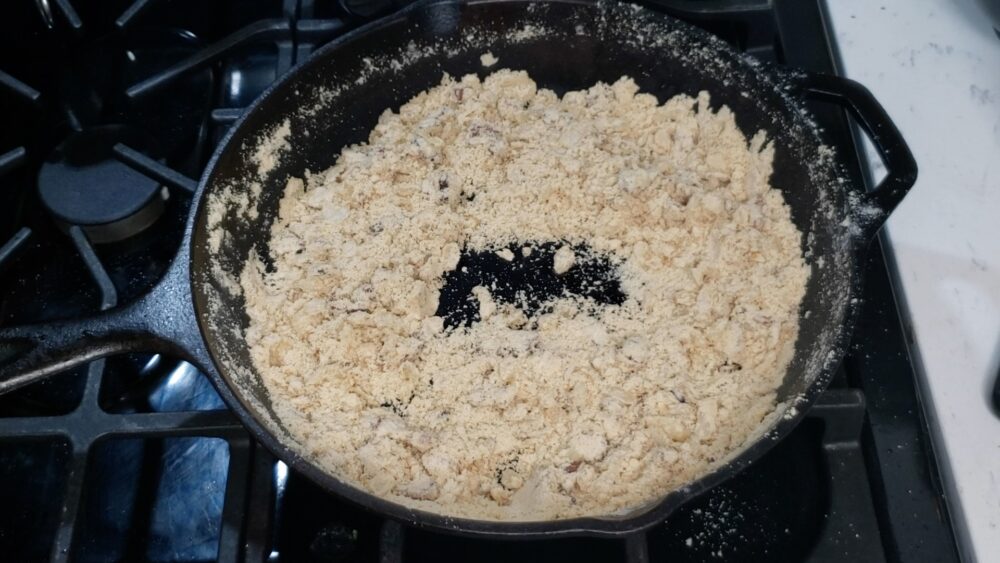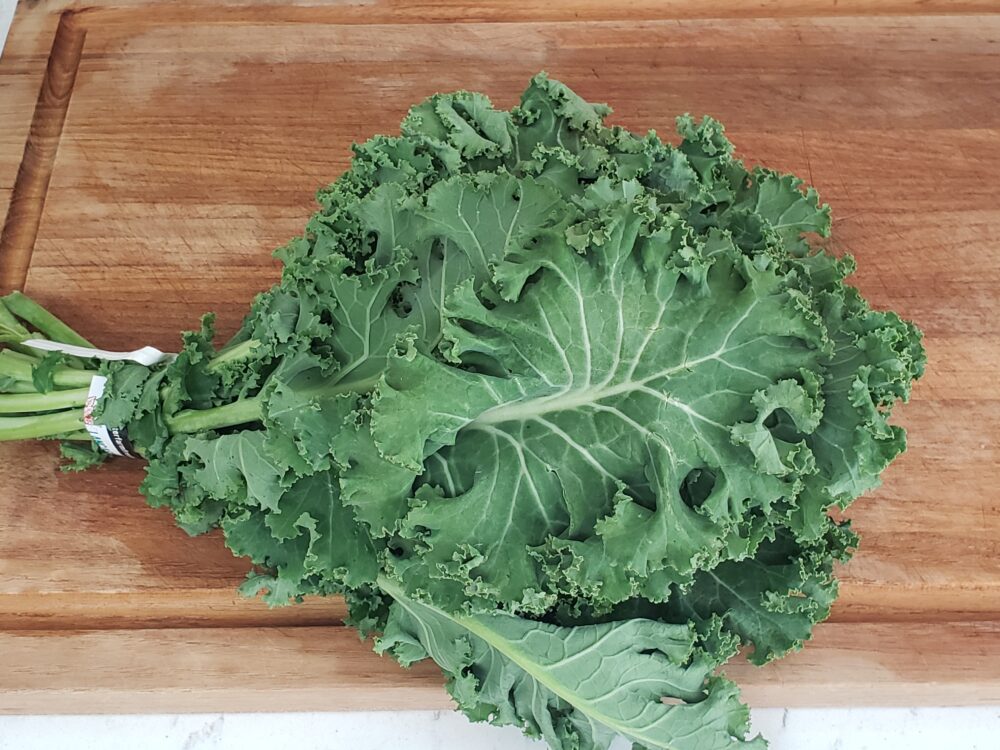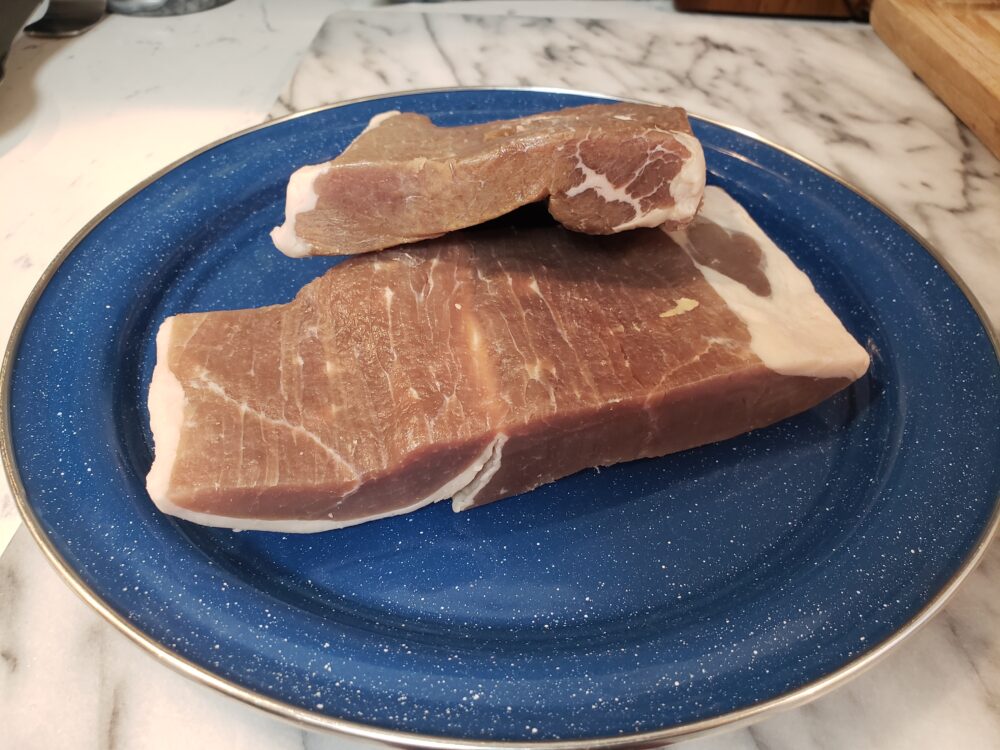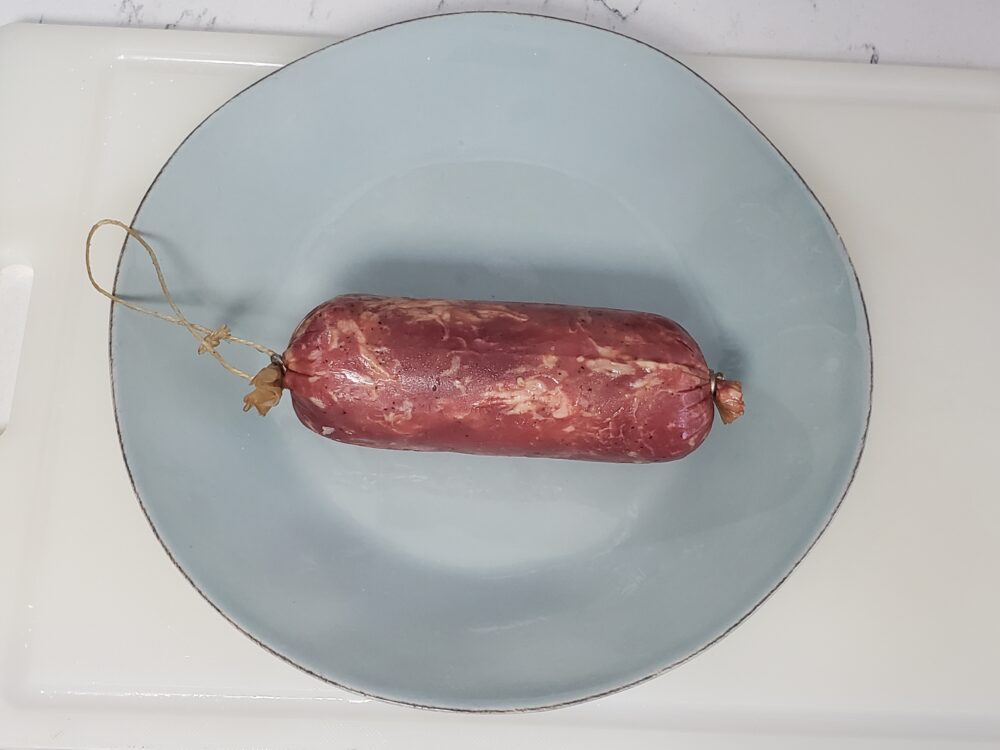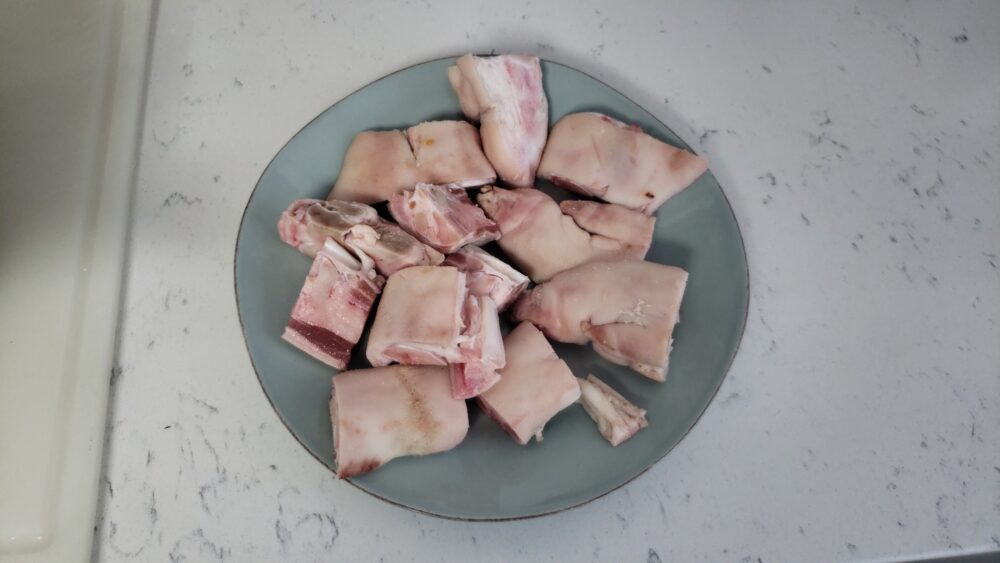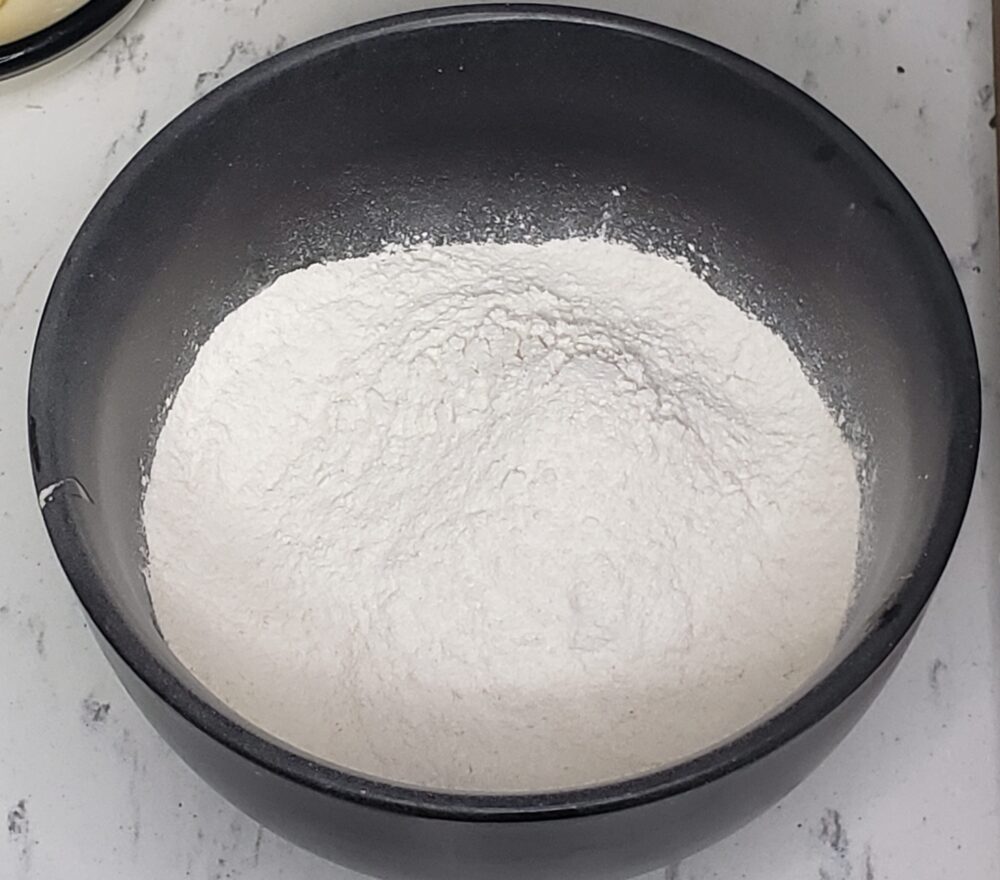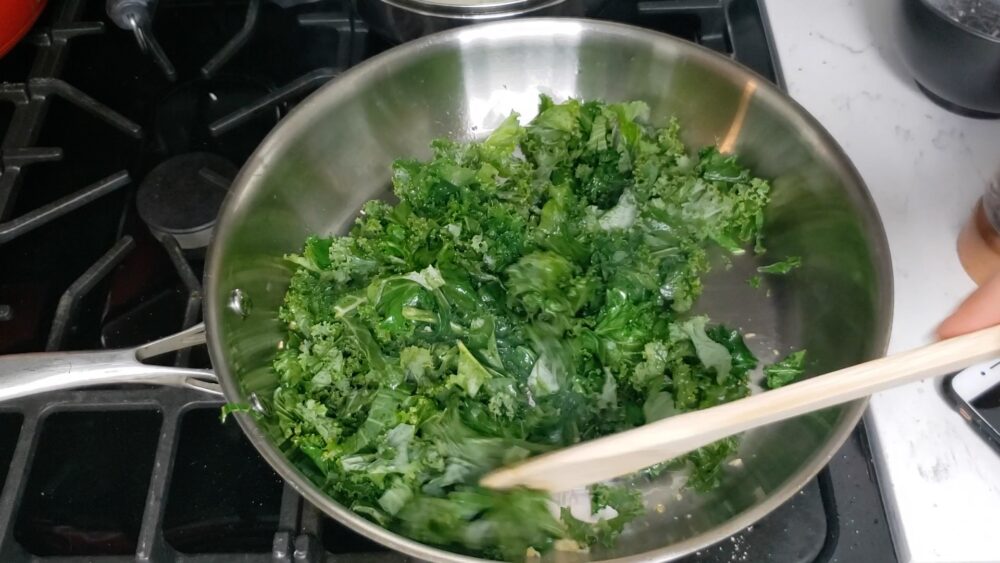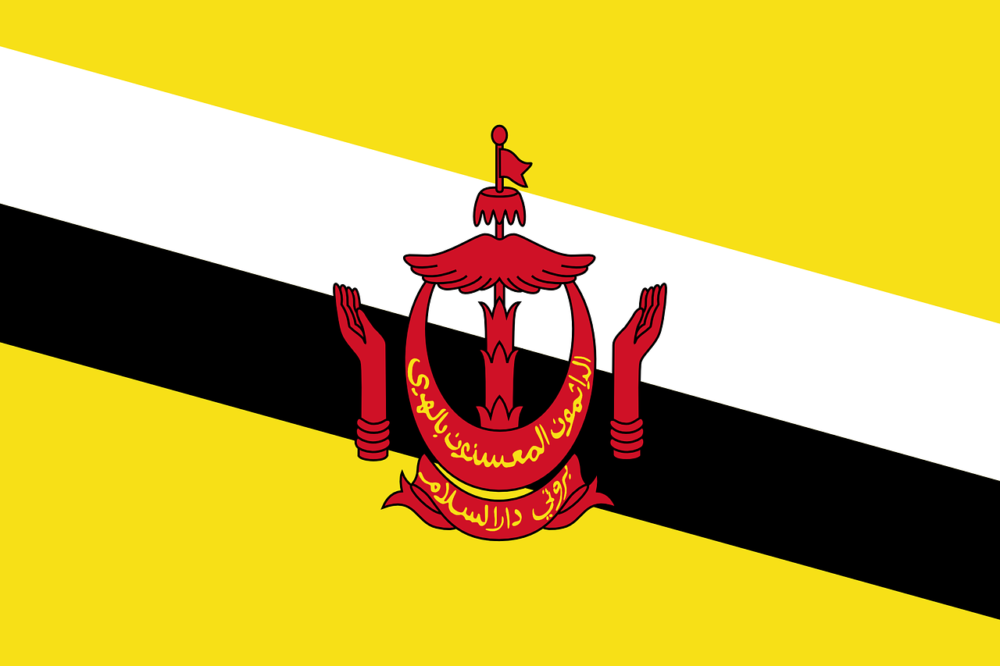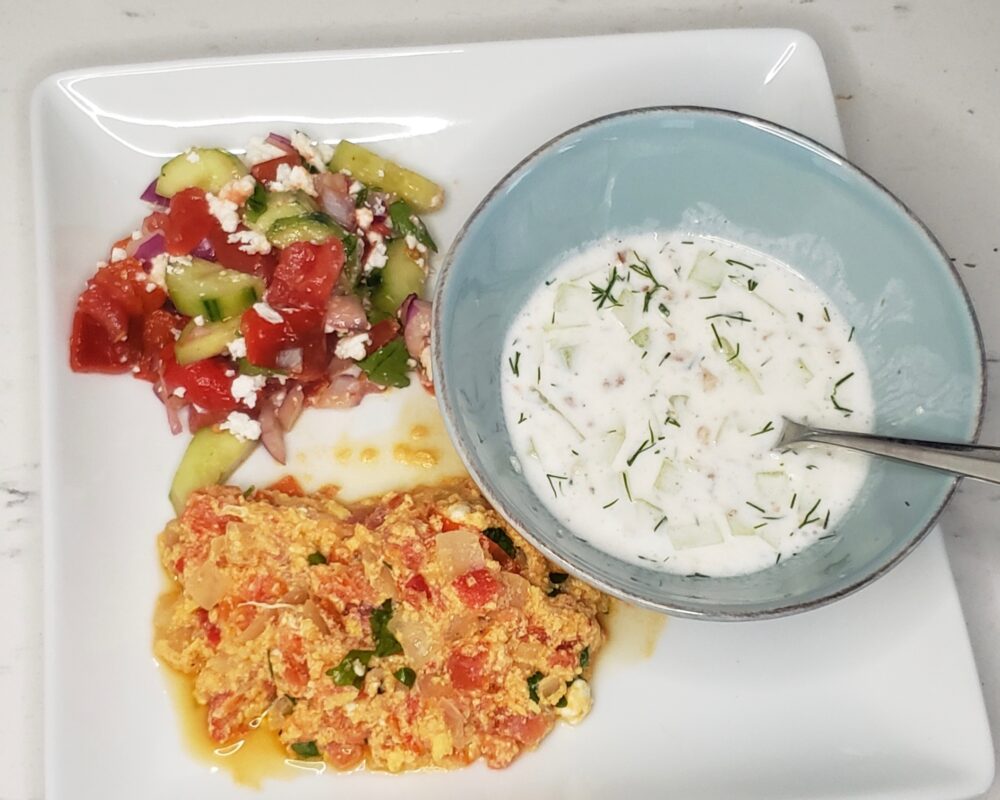Go big or go home they say. And if you don’t want to go home, maybe go to Brazil. It’s a huge country with a huge cuisine. This week, we get a little (or big) taste of the colorful and hearty food from Latin America’s largest country.
THE PLACE AND ITS CUISINE
Brazil is hard to miss right there on the western (and central) side of South America. In fact it takes up about half the continent’s landmass. It’s the only country on the continent where Portuguese is the official language.
Brazil is also made up of highlands, coastline, waterfalls, and the Amazon basin. Brazil contains 60% of the Amazon rainforest, which is the largest in the world. Because of that Brazil is one of the most biodiverse places in the world with thousands of different animal species living in the country. That being said, poaching and deforestation is still a major problem in Brazil.
Its cities (like Rio de Janeiro and Sâo Paolo) and beaches are world famous. After celebrating Carnival or a soccer win, they might dance to some samba or funk. And there is plenty to eat.
Since the country is so huge (its the largest in South America by far), its cuisine is also hard to pin down and is massively diverse with influences from Europeans (especially the Portuguese and its colonies), African, native American, and even Asian. Believe it or not, Brazil has the largest population of Japanese people outside of Japan.
The diet in the Amazon is quite different from that in the cities. It includes lots of freshwater river fish you may not have heard of (like peixe nobre, pirarucu, and tambaqui) and exotic fruits (like acerola, graviola, cupuaçua, and buriti). Brazil is also the home to the now very popular and trendy Açai berry, considered one of the world’s superfruits.
Manioc (or cassava root) is one of the ingredients eaten in both the rainforest and practically everywhere else in the country.
Along with fruits, root vegetables, and leafy greens, meat is usually a major part of the meal. Brazilians are very adept at grilling perfectly salted meat over charcoal grills. The tradition is similar to Argentinian asado. Restaurants called churrascarias regale you with skewer after skewer of barbecued meat, including the famous picanha.
Stews with beans and meat or coconut milk, fruits, and fish are also very common, especially at homes.
Pastries and cocktails are also ubiquitous. Many meals are accompanied with cheese breads made from yucca flour (Pão de queijo) and end with a sweet (like chocolate brigadeiros, passionfruit mousse, or a coconut custard called Quindim).
And to wash it down, Brazil is the home of cachaça (an alcoholic sugarcane spirit) and all the cocktails (mostly famously caipirinhas) you can think of using it in.
And truthfully, this is barely scratching the surface of the depth of traditional dishes in Brazil. A gargantuan country has a gargantuan
Other traditional dishes:
Moqueca – varies based on region, but usually a rich seafood stew made with tomatoes, coconut milk, and lime
Coxinha – a very popular street and bar food; deep fried pear shaped croquettes stuffed with a variety of ingredients, but often shredded chicken
Pato no Tucupi – an Amazonian stew made from roasted duck and vegetables in a sauce made from cassava juice and jambú (a leafy herb with medicinal properties).
Churrasco – this is the term for barbecued meat usually cooked and served from skewers
BRAZILIAN FOOD IN NEW YORK
While most of the restaurants and Brazilian community today can be found in Astoria, Queens or just over the river in Newark, New Jersey, many New Yorkers may not even realize there is a small little street in Midtown known as “Little Brazil.”
Little Brazil (46th Street between 5th and 6th Avenue) used to be home to many Brazilian and Portuguese businesses. Today there are two Brazilian restaurants on the street (Via Brasil and Emporium Brasil) keeping the traditions alive and festivals will happen from time to time celebrating the culture (and food).
But this street is by far the only spot in the city for a great taste of Brazil. If you wanted to go full hog and eat all the meat you can imagine, there is long standing Churrascaria Plataforma and a few locations of the chain Fogo de Chão.
For a more modest homecooked meal, there is the excellent Berimbau and Casa, both in the West Village.
Out in Astoria, where the more recent Brazilian immigrants have settled, I tried both the famous feijoada (which we will cook on this adventure) and a grilled steak called Entranha Grelhada at Favela Grill.
For smaller bites, there is the awesome coffee shop O Café; Brigadiero Bakery, a dessert bar specializing in the famous chocolate truffles; and Santo Brúklin, a bar and restaurant in Carroll Gardens with killer pão de queijo (yucca cheese puffs).
However, my favorite Brazilian restaurant is actually not in New York at all. It’s a short PATH ride away into Jersey City, where I used to live.
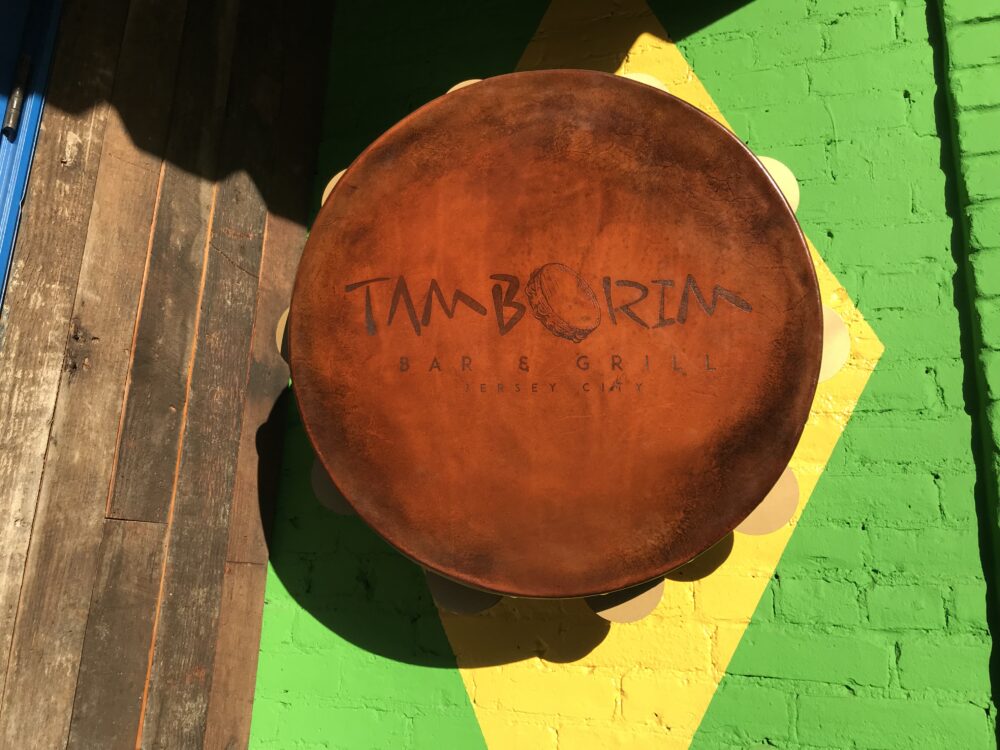 Tamborim Bar is owned by Michael Casalinho, who I became friends with by being a regular at his previous Portuguese restaurant Broa. The menu of food and cocktails is both innovative and traditional and the vibe is incredibly authentic and lively. His moqueca is out of this world. In addition to being an amazing chef, Mike also helped us out with this experiment by providing the meat for the feijoada.
Tamborim Bar is owned by Michael Casalinho, who I became friends with by being a regular at his previous Portuguese restaurant Broa. The menu of food and cocktails is both innovative and traditional and the vibe is incredibly authentic and lively. His moqueca is out of this world. In addition to being an amazing chef, Mike also helped us out with this experiment by providing the meat for the feijoada.
There are specific sausages and cuts of meat that are most traditional and I reached out to Mike to see where he suggest I go to find them. He said Newark would be the place, but I could just swing by and he’d supply me with a portion. How’s that for service?
So this journey would not be nearly as successful if it wasn’t for Mike and Tamborim Bar.
THE VIDEO
Sam is very excited about Brazil because of its biodiversity and its love for smoky meats.
A good deal of this video is talking through (and smelling) each of the meats. The pig parts threw Sam a little for a loop, but once he realized what we were doing, he became eager to find all the pig parts. Even the eye!!
Even though we do make a nice sautéed green dish, this video is not for vegetarians or the meat averse. For those who do eat meat, you might find your stomach rumbling throughout. So regardless of your dietary preferences, proceed with caution.
THE DISHES
So this is really like one full dish comprised of a few different components. And in Brazil, where this is the National Dish, it is almost always eaten this way.
It’s also such a labor intensive and massive plate that it is usually served only one day a week. That day varies depending upon region, but often it is on Saturday or sometimes Wednesday. And as you can imagine, it is the main meal of the day.
Feijoada is the main course of this plate and it is essentially a rich smoky black bean stew with all the meat you can think of. The meat inclusions vary from recipe to recipe but it is unusual to not see some kind of sausages, bacon, pork, carne seca (dried beef), and ribs. Traditionally, it also would have included pig parts, like the snout, ear, and feet. It also has to stew for many many hours. So sometimes it is made the night before and re-heated to allow all the flavors to come together fully.
The word feijoada comes from the Portuguese “feijão) which means beans. And there are plenty of beans in this pitch black stew. In other Portuguese speaking countries, other beans can be used.
One story is that African slaves created this dish by using all the leftover parts of the pig. But the more likely origin is actually European settlers from places like Portugal who often found ways to cook beans and meat in large portions. Feijoada is probably related to the French cassoulet.
So now that we know about feijoada, you’ll also find something called Farofa on the plate. This is an unusual garnish of toasted cassava (also called manioc or yucca) flour. It’s generously sprinkled on top of meat and fish dishes, especially feijoada.
It provides a very unique crunch to the dish and if there was any hope you were going to eat feijoada and leave hungry, farofa squashes any concerns.
And the other dish here is called Couve a Mineira, which is a simple sautéed greens recipe with olive oil and garlic. Sometimes with bacon, but I figure we’ve had enough bacon on this plate already.
Collard greens are usually the greens of choice in Couve, but I’ve also seen recipes using kale. We happened to already have a bunch of kale and so it was a no brainer to do that as well.
And if that colorful plate was not yet enough, Feijoada is usually served with white rice and slices of orange segments.
This might have been our biggest undertaking yet.
SPECIAL INGREDIENTS
Most of the special ingredients for this dish are meats, but not the usual cuts or preparations. I was planning to go to a Brazilian or Portuguese market in Newark, but I reached out to my friend from Tamborim Bar asking him which market he recommends. And he said, just come to the restaurant and he would hook me up. And he sure did hook me up!! I got all the meat I was hoping for and then some.
Carne Seca
I compare Carne Seca (which means dried meat) to a cross between corned beef and beef jerky. It’s heavily salted and dried and requires some rehydrating in water before using. In that way, it is not so different from the saltfish we used in our Antigua and Barbuda experience.
Sausages
If there’s one thing you must include in feijoada (aside from the black beans), it seems to be a generous amount of Brazilian sausage. I was lucky enough to get two very authentic varieties.
Linguiça is the sausage most people think about when it comes to Brazilian cuisine. There are variations for making liguiça but it is a pork sausage that is cured and smoked. Sometimes there is some heat to it, but not always, Lucky for Sam, ours didn’t have much spice – only lots of flavor.
The other sausage Mike gave us was not on my list of ingredients, but I’m sure glad it ended up in the pot. It’s called Paio and you can see it is fatter and harder than linguiça. It’s made from pork loin, garlic, and pepper before being smoked. Sam says it smells like bacon.
Pig Parts
So it seems like most modern recipes for feijoada omit the pig parts. I guess people today are more squeamish than people back in the day. These “leftover” bits of the pig aren’t found in all the recipes I discovered.
Considering that it’s normally a bit more difficult to get these lesser used parts, I was not expecting to add them to our feijoada. Once agin, Mike stepped in.
He graciously gave us a container of tail, feet, and back. Sam wondered where the eyeball was?
Cassava Flour (Manioc)
The cassava root goes by many names: manioc, yucca, and even tapioca. It’s the fifth most important crop in the world and is very popular all throughout Latin America and Africa. It also turns out it is native to Brazil.
They cook it in many ways: boiled, fried, roasted and in larger dishes. It is the base for both pao de queijo (that famous cheesy bread) and tapioca sandwiches (which is really worth a try if you can find them). All gluten free, mind you.
We used cassava flour before back when we made funje from Angola. For that dish, it was stirred into a porridge. For Farofa, it’s simply toasted in fat.
THE RECIPES
Inspired by:
easyanddelish.com
seriouseats.com
gnt.globo.com/receitas
braziliankitchenabroad.com
Feijoada with Couve and Farofa from Brazil
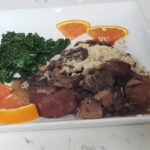
The most famous and National Dish of Brazil, this is a labor intensive and very hearty black bean stew with all the meat you can imagine. This is a dish to impress and have leftovers for days.
Feijoada
- 1 pound black beans, dried ( )
- 1/2 pound carne seca
- 1 pound pig parts (including snout, feet, and ear)
- 3 slices bacon (chopped)
- 1/2 pound linguiça sausage (sliced)
- 1/2 pound Paio sausage (sliced)
- 1 onion (chopped)
- 3 cloves garlic (minced)
- 3 bay leaves
- 1/2 tspn cumin
- Kosher salt (to taste)
- orange slices (for serving)
- cooked white rice
Farofa
- 1 cup cassava flour
- 2 slices bacon (diced)
- 2 tbspn butter (divided)
- 1/2 onion (diced)
- 2 cloves garlic (minced)
- salt (to taste)
- black pepper (to taste)
Couve
- 1 bunch collard greens or kale (sliced into strips)
- 1 clove garlic minced
- 1 tbspn olive oil
- salt (to taste)
- black pepper (to taste)
Feijoada
Soak the Beans
-
Cover beans with 3 inches of water. Stir around with your hand to remove any stones or impurities. Strain, rinse, and put back into pot. Cover with double the amount of water, add some Kosher salt and soak for 12-24 hours.
Prepare and Cook the Meat
-
Soak the carne seca in water for 24 hours.
-
Rinse the pig parts in water and then cut into pieces.
-
Cover carne seca and pig part with water and bring to boil. Boil for 10 minutes. Using a slotted spoon, remove the meat and add into a large bowl. Discard the water.
-
Heat Dutch oven or large pot and cook chopped bacon for 3-5 minutes until browned. Remove with slotted spoon and set aside.
-
Add sausages to pot and brown for about 5 minutes. Remove and set aside.
-
Add chopped onion and cook until softened, about 5 minutes. Add garlic, salt, and bay leaf. Stir for a minute or two until fragrant.
-
Add pre-soaked beans, cumin, and stir for a minute or two. Then cover with water by about 2 inches. Bring to a boil.
-
Now add precooked carne seca and pig parts and lower heat to medium low. Cover and cook for 30 minutes.
-
Then add the bacon and sausages and cook at a simmer for 3-5 hours adding more water if necessary. Skim any fat or impurities off the top.
-
This can be made in advance, refrigerated and re-heated on stovetop when ready to serve.
-
Serve with farofa, couve, white rice, and orange slices.
Farofa
-
Add bacon to a cold cast iron skillet. Heat to medium.
-
Once fat renders, add 1 tbspn of butter. When it starts frying, add 1 more tbpsn of butter.
-
Add diced onion and cook until transparent, about 2 minutes.
-
Add garlic and continue frying until golden.
-
Add cassava flour and season generously with salt and black pepper. Constantly stir gently to toast flour, but making sure it does not burn. About 2 minutes.
Couve
-
Add olive oil and garlic to frying pan and bring heat to medium. After 1 minute or so when garlic becomes aromatic, add sliced greens and sautée for about 3 minutes or so. Season with salt and pepper to test.
HOW WE SCREWED IT UP
The biggest problem we had was that we just couldn’t finish the amount of food we made. It was a bit absurd.
For better or worse, we had leftovers for weeks. Good thing this freezes well.
Perhaps I owe it to Mike from Tamborim Bar, but this came out extraordinarily well. While it is labor intensive, it’s a bit difficult to mess up. As long as you use the right ingredients and you simmer it for long enough, the flavors will reveal themselves.
Feijoada was a huge success!
I was also worried about burning the Farofa, or not cooking it long enough. But I think my patience and carefulness paid off. It added the right amount of texture and subtle flavor.
And by now, if I can’t sauté some greens, I ought to get out of the kitchen. The Couve was also good.
All in all, we conquered Brazil!!
SAM’S REACTION
Sam makes it clear in the video that he likes all his food separated. So it was a stretch to get him to try a dish that is all about everything in one pot.
But since he had a nice sniff of the smoky meat sausages, he was very happy to try them once I picked them out of the stew. And he absolutely loved both sausages. One day he will understand that the beans soak up the smoky meaty flavor of the protein and he will love that as well. I have no doubt, but until then we’ll have to keep it separated.
NEXT TIME
We’re traveling back to the other side of the world to the island of Borneo, which houses many countries, including the tiny oil rich country of Brunei Darussalam, an Islamic nation that is home to rainforests, beautiful mosques, and a very favorite fast food…

